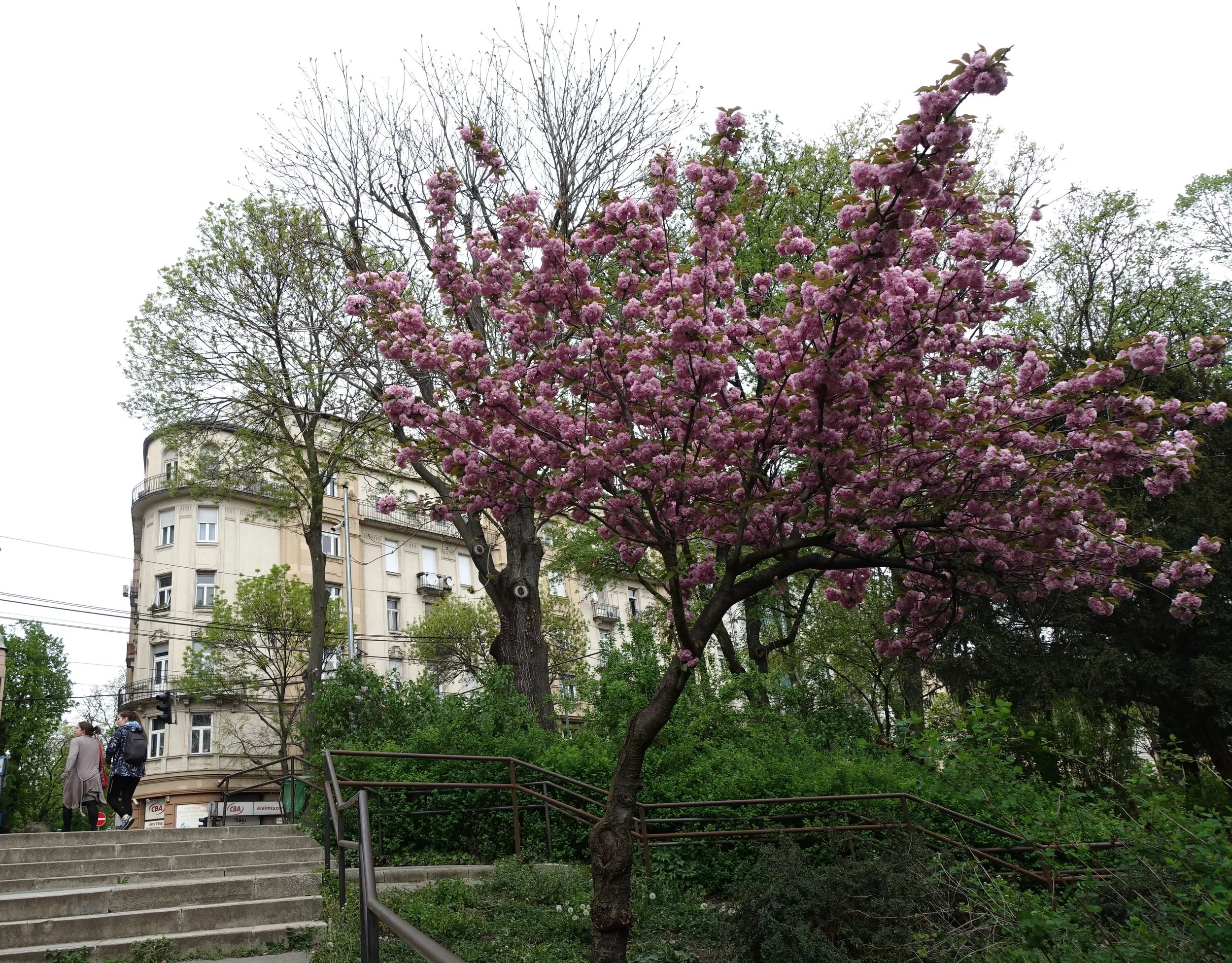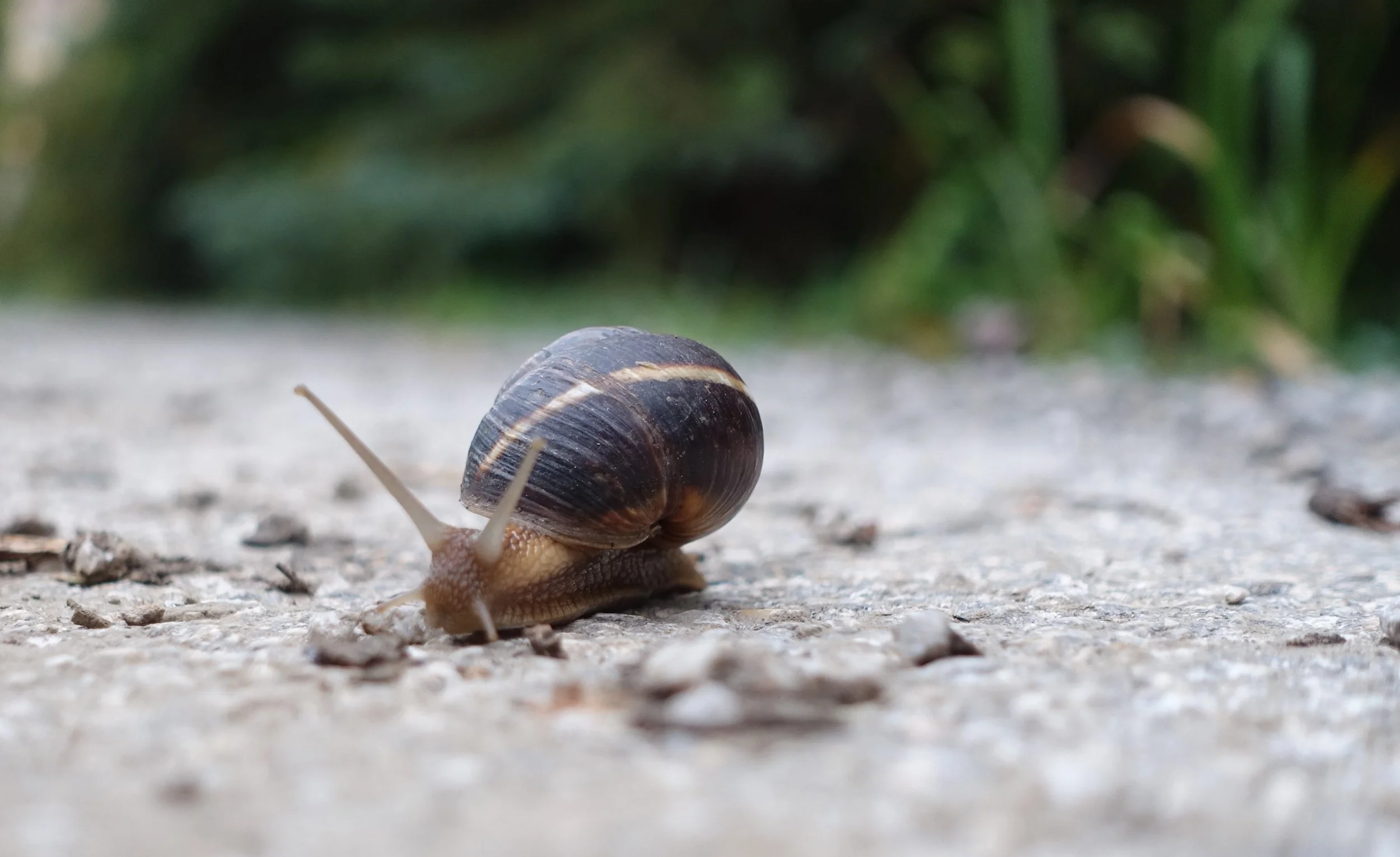A paradise for hostas!
Waiting for the rain-Óbuda
The weather in April 2024 has been as capricious as only April can be. It was 29.4 degrees Celsius on Sunday 14th, the highest recorded temperature on that day in Budapest since records began. It was a pleasant 27 degrees C on Monday. Then it rained quite heavily on Tuesday and the temperature dropped to 11 degrees (51.8 if you work in Fahrenheit). It was wet, windy and overcast but quite a relief that Hungary wasn’t going to slip into a sustained early summer, leaving clothing retailers unable to sell spring offerings and seeing an early run on suntan lotions. From a gardening perspective it meant the summer wouldn’t be over by June. It had looked like heading in that direction after such a mild winter, with flowers appearing weeks earlier than normal. From the farmer’s perspective as well, spring rain is essential to guarantee a good yield by August and September. In 2022 the rain came at the wrong time: hardly any in the spring, plus late frosts, then bucket loads in the summer and the result was a sodden, devastated harvest. The pumpkin and corn crops were almost completely destroyed.
January felt pretty cold this year and the narcissi flowered about a week later than in 2023. February and March were mild. Spring is arriving increasingly early here but along with severe cold snaps and extreme summer temperatures, makes gardening more difficult than in northern Europe. At least that’s true for me. As to be expected January is dry and cold, even without snow, and removes the illusion that Mediterranean conditions prevail. The communists strived without success to grow a Hungarian orange outdoors in balmier parts of the country. Of course, with climate change this may become possible one day in some sheltered valley in the south of the country.
February in Budapest this year was amazingly mild and sunny. Yellow primroses came early to brighten up lawns. Little blue vinca flowers shone out along shady pathways in March. Cherry tree blossom attracted legions of phone snapping tourists along the Castle walls. Tulips sprung up much earlier than expected. Our pelargoniums were growing happily on the balcony long before the clocks changed. A late frost may still freeze their delicate fronds before they really get going. Yesterday’s newspapers (22nd April) reported that a coating of snow had fallen on Mount Kékes, the country’s highest peak. Swirling cyclones may lead to further wet and cool weather. Some people are wearing shorts, others don their winter coats. I might have to protect those zonal geraniums that should flower scarlet later this year.
Spring cherry blossom-Városmajor park
Until Tuesday last, things were shaping up like a good, early British summer. Blue forget-me-nots and red tulips had already appeared together in the more design focused, municipal bedding schemes. They have done their business and turned to seed in most cases. Winter flowering pansies that often last until May are looking scorched and mildewed. It’s not clear if April showers will extend their biennial existence much further. Dandelions are only puff balls now, their leaves looking far from edible. Soon clouds of horse chestnut blossom will depart the parks and gardens and shower local residents or tourists with speckles of white and pink.
My experience of gardening here is mostly in terms of balconies and window sills. I have only made one planting attempt directly into the Danube flood plain which I mention later. Scratch below a garden’s surface in Pest and you will find sand like that of Margate beach. Here in Buda, there are many hills, volcanic rocks and alkaline soil conditions to contend with as well.
At last weekend’s plant sale at the Buda Arboretum, there were an abundance of plant species available to purchase. A man walked past with a foxglove, almost in flower. I wondered how long it would last in the arid earth here, so far from the west country or Wales where they love damp soil and moist air. Of course, it’s horses for courses. Oleander for example flourish in Hungary, some even surviving outside in the winter at Lake Balaton and other milder spots. In the UK, they would struggle to survive outside of a green house. There are numerous other plants that thrive in this climate and a large crowd gathered at the Arboretum stalls. The event had a similar atmosphere to a British garden show and some prices to match for the rarer specimens.
Spring plant sale at Buda Arboretum
The interesting action happening in the garden occurs in April, May and June here. Conditions are comparable to June, July and August in the UK, with weather conditions something like the British summer. Minus the incessant rain- but still damp enough to keep everything green and lush. Massive tree paeonies bring colour to botanical gardens as early as April. Purple irises raise their nautical like flags everywhere. Unexpected delights like acacia blossom will make otherwise grimy streets, smell sweet later in the spring. June is often the wettest month and if the temperature has risen high into the twenties, the window boxes and balcony plants are well watered without human intervention and petunias and geraniums bloom like mad. Blue strings of lobelia can cope with these almost tropical days but will become frazzled later in the summer unless hidden in the semi-shade.
Tree paeonies-Buda Arboretum
When we lived in Pest, there was an initiative in Ferencváros to brighten up the dirty flower beds outside our building, along Üllői út. They were devoid of plant life although bordered by trees that somehow survive the twenty-four seven traffic pollution here. The local council offered a few free plants to local residents and to the amazement of passing pedestrians, I planted extra ones next to the six-lane road that brings traffic from the south into the city centre. While the rain fell in June, my hostas and coleus started to flourish. Unquestionably surprised to find themselves in such bleak surroundings, they were nonetheless sufficiently well- watered. Once endless clear skies arrived late in the month, there was no keeping up with the blue blast. The nearby stunted trees failed to provide protection for the south-facing bed and heat radiated off the high city walls to magnify the oven-like effect. Temperatures rarely dropped below twenty-five degrees that summer-- day or night and it was a challenge to keep up with the watering.
The greening of Üllői út was something of a disaster along the whole length of road and I haven’t seen that experiment repeated. It would need real gardening experts to find the right plants to survive in such conditions and endless policing to keep dogs and vagrants from disturbing the beds. Taste and decency prevent me describing what I witnessed a local tramp doing to my hostas. Suffice to say that at this point, I knew the game was up and left the poor specimens to take their chances. I knew my watering would be in vain.
Guarding the window box -Ferencváros
July and August are mostly dry and scorching. Lawns become parched and scraggy because of tall trees that keep homes cool but cut out much needed light from the earth. Perennials like achillea that have a long life further north, go to seed much earlier. Delphiniums are spindly and weak although they retain their brilliant blue petals. Spring roses bloom beautifully but summer rose gardens are blighted places with lines of cracked earth separating the species and the blossoms small compared to their UK equivalents.
There are exceptions. In Buda the crocosmia do particularly well, growing on street corners like weeds. Coleus are stars for the balcony planter, surviving and flourishing in the harshest of shady corners. Lavender and Mediterranean herbs endlessly release their scent on blazing summer days. Tree foliage and fruit provides the most interest over long August weeks. Wild fig trees appear in unexpected places to provide tasty delights to harvest. There are some winners from the drought. Hungary is a paradise for hostas. Slugs and snails are simply immobilised in this dry and sandy world. Despite the lack of rain, hosta leaves will remain largely intact well into autumn, until low night temperatures suddenly decimate them.
Can’t find the hostas!
Why aren’t there problems with the supply of drinking water you might ask? Certainly, the huge reservoirs to be found all over the UK would simply become vast, empty canyons here. Instead, Hungary benefits from being at the bottom of the Carpathian Basin. Rain water falling on the mountains of surrounding countries seeps down to the plain below. As a result, over 90% of Hungarian domestic consumption comes from groundwater supplies. My neighbour tells me that it is increasingly hard to reach the good drinking stuff but at least the possibility of drought never arises. The continuously flowing thermal spas of Budapest bear testament to this abundance, although I don’t know if you should water your plants in such mineral rich liquids.
By the time the clocks change the gardening year is almost over: hardly a surprise in the northern hemisphere. Only in the eastern wine region are people harvesting grapes that are almost rotten and will benefit from the rich sugars released by the first frosts. The resulting Tokaji wine is sweet beyond belief and was reputably our former Queen’s favourite tipple. By December, spring bulbs are already pushing their way through. Yes, this can happen in the UK too. We may soon see daffodils flowering at Christmas everywhere in Europe. That would be a rum deal indeed!





